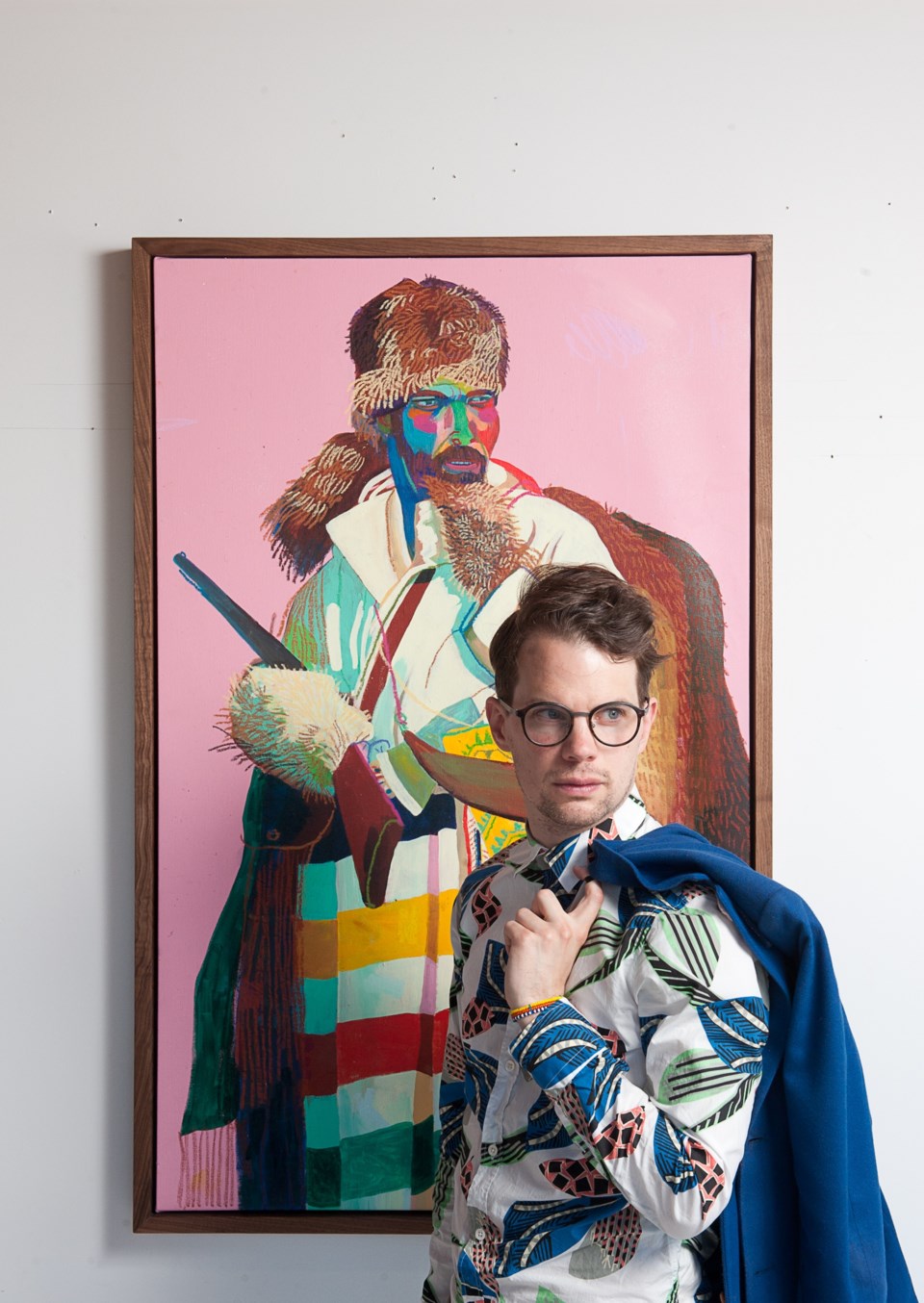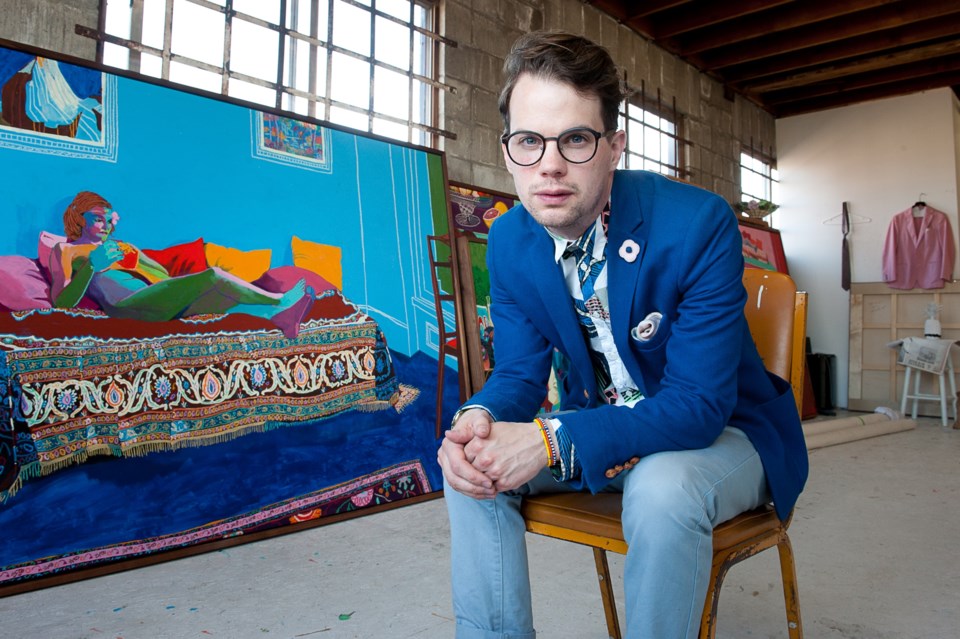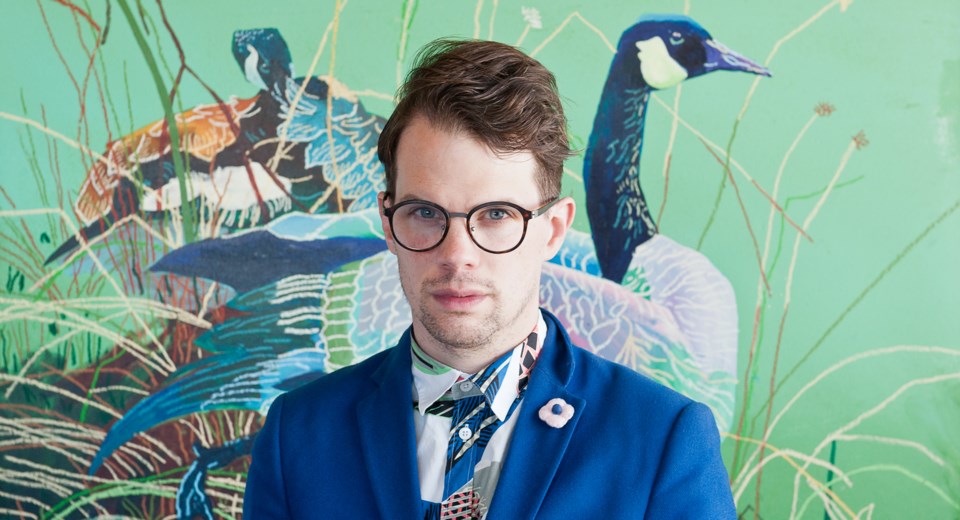Old punks never die, they just stand at the back – or so the saying goes.
But what about young punks? What do they do when the craving for anarchy wanes…
If you’re Andy Dixon, you take up fine art painting, apparently.
For most of his 35 years, Dixon has been best known as the former guitarist/vocalist of d.b.s – a North Vancouver punk band that formed in 1992, when the members were still in Grade 8.
Between the tender age of 12 to when the band broke up in 2001, Dixon and co. toured with the likes of Rancid, Anti-Flag, and D.O.A. Meanwhile, in keeping with the DIY mentality of his punk rock ilk, Dixon would often find his talents extended to drawing the album art and making the band posters.
After d.b.s, Dixon stuck with music, playing with The Red Light Sting, tweaking knobs as The Epidemic, and mashing samples as Secret Mommy and Caving. His DJ sets were sweaty and his live performances raw.
Then Dixon started painting. The art was immediately arresting – witty, Basquiat-like scribbles of images and text on numb beige backgrounds. But still they sat in his portfolio next to T-shirt designs and album covers.
Then, in 2012, he really started painting: Sumptuous, psychedelic colours clashing with unexpected images of nostalgic luxury: bare, fauvist breasts aching to be set on fire, mottled emperors on horseback and neon exotic pets, transected with slashes of crayonesque pastel.
The glitchy music, the artful posters, the corporate designs slowly took a backseat to solo shows, gallery gigs in Austin, New York and London, and a full-time painting career.
But what of the punk? Is he now screaming expletives onto canvases and into the living rooms of the rich?
We caught up with a paint-spattered and sweatshirted Dixon in his airy Mt. Pleasant studio, surrounded by canvases for Canadiana, his fourth Vancouver solo show, at Initial Gallery.
Always one to source inspiration through images, Dixon has delved into Google’s image banks to piece together an intriguing homage of sorts to Canadian art: Group of Seven, Robert Bateman, Jeff Wall, and Ian Wallace imagery or influences appear throughout the eight paintings – remix, sampled, stylized.
About to leave for New York for six months to paint, the patriotic timing couldn’t be better. And as he curls into a green velvet chair in the corner of the room, the eyes of the Canadian legends are upon him.
Tell me about the theme of your show? Did you pore over old Maclean’s magazines for inspiration?
Ha. Yeah, basically. The Internet equivalent of. I’m certainly not an expert when it comes to Canadian art, but that’s sort of part of it. It was whatever I could think of… Oh yeah, Group of Seven, I should probably do something there. Google image search. Oh, Robert Bateman, I should do something with that. It was a lot of fun to find little morsels and reference points to slip in there.
Did you learn anything about Canadian art history in the process?
Yeah. I learned some of the names in the Group of Seven, for instance.
Ha. Most people only know the one name.
Everyone only knows Lawren Harris! For the most part it’s kind of like, intentionally naive. So, I don’t know if I learned very much because it’s quite surface-y. I dug no deeper than a Wikipedia page or an image search. It’s sort of like today’s Internet culture-version of research.

You’ve talked in interviews before about how your art is pointedly not political; would that be why you don’t delve too deep into what you’re trying to say?
Totally. Absolutely. Nevermind the Canadiana show, I’m sure with some of my portraiture of French Kings, for example, I could find out that they’re the worst people on earth. It’s aesthetic research more than anything else.
Does it ever get inadvertently political?
I think people tend to see politics in everything. I think especially when you’re dealing with images of class; it’s just a knee-jerk response to think that I’m trying to say something poignant about class. The only political statement in the work is the lack of political statement. It’s sort of exposing that viewer’s judgement of the subject, or of me for painting the subject.
Because you’re loosely painting from life, do you view your colour treatments as an improvement on what you see?
I wouldn’t say I’m improving; I’m just joining in the conversation. I’m certainly not saying, ‘Here’s Jeff Wall, but better!!’ It’s just a series of references. I mean, authors have been doing it for thousands of years. Pretty much everything is the Bible if you trace it back far enough [Laughs]. I like that; I like allusions to predecessors. I think it’s an important thing. I think that it’s possible that certain facets of modern art are losing sight of that. We still owe a lot to the Matisses and Caravaggios…
I think most audiences, whether they like to admit it or not, need a bread crumb trail.
Yeah, I think so. I think the breadcrumb trail is cool! Not doing that reminds me of my more arrogant punk days, where I thought that punk music was so detached from musical history and it was “brand new”. Whereas when you get older and you listen to everything you know that’s fucking bullshit. Obviously. Those reference points and nods to various things that led up to this moment are super important, and we shouldn’t overlook where art has come from. I’m all for pushing it forward, but we should have that respect for the past.
How much has your early exposure to the punk scene informed your art?
I think it has in many different ways, whether it’s things that I learned from the punk scene or things that I specifically didn’t like about the punk scene. I think choosing to use images of luxury is definitely an antithesis to my punk lifestyle.
Because you started so young, are you now a world weary artist?
I don’t know. I mean, I’ve only been a painter full-time, or with any real serious conviction for like, three years? Maybe as you get older you figure out how to carry experiences, even if they don’t directly relate directly to painting, you figure out how to apply them practically to the next thing. So you’re not starting from scratch each time, you learn plenty, and that’s evident even in the way that I talk about my art and the art world. I can only do it in music metaphors basically. [Laughs]. I have 15 years of musical experience, learning how the music business works, which is pretty similar.
Do you think it’s kind of crazy that that isn’t your main focus right now, in basically the prime of your creative career?
Yeah. Kind of. Yeah! But I think it’s crazy in a good way. Either I’m in the prime of my creative life and I switched it at a weird time, or switching just created this impact where I was fully charged and ready to go – I had learned all these things in this other world and I was fresh. Or maybe I’m just a better painter than I was a musician! [Laughs]
Ha. It’s possible. We’ll leave that to the readers to decide... You’ve talked about how the punk scene was very do-it-yourself and those principles are how you figured out how to paint. Can you explain?
A friend of mine talks about how people who all grew up in the same moment have “The Understanding”. It’s hard to describe but it was a weird thing that happened in the ‘90s and early 2000s where very eager, music-driven people put on shows in the most random places. That kind of do-it-yourself, just make it happen – you have an idea, just do it – really stuck with me. It is absolutely a part of everything I do.
Another thing I think is sort of a parallel to the punk world in my work, is, in a way, punk music was a kind of outsider art, meaning the idea wasn’t to have a lot of academic or technical prowess. You weren’t trying to impress anybody with your raging guitar solo. It was about emoting and expressing yourself outside of this idea of technical perfection. I think that’s something that’s been with me in everything that I’ve done since. Anyone can lock themselves in their room and learn to play guitar with the perfect amount of taut emotion, but that doesn’t mean it’s good.
It’s even in the images you create. They’re all very romantic, but there’s also a bit of a “fuck you” happening.
There’s always a “fuck you” happening. There’s a constant paradox, which I equate to another era of music making, which was sampling. I’d make a track out of a Pink song and so it’s this idea of turning pop culture back on itself. But at the same time, I’m an aesthetically minded person, so now I’m digging through the Pink song trying to find the best part to sample, and I’m kinda starting to like the song. It’s now this duality. There is an intention to subvert but also to highlight the beauty of it, in a way.

Do you ever get called on your sampling of photography or artwork by other artists?
No. I think to stylize somebody else’s work is again that idea of joining in on this conversation. And it’s never a 100 per cent reproduction. That has been changed, this has been changed. And another part of what I’m doing is a nod to modern Internet culture and this idea of the consumption of the image, and the sharing of the image….
…who owns what?
Exactly, that’s been a huge theme of mine since I was making songs out of Pink songs. It is a sort of copyright challenge. Intellectual property rights is a very interesting concept to me.
Ever wonder what the artists you reference would think?
That’s a good question, and I think that if there is ever going to be an opportunity to find out, it will be this show. I mean, Ian Wallace lives here, Jeff Wall lives here. Maybe for the first time ever the “Great Conversation” will become a real conversation.
• Andy Dixon: ‘Canadiana’ is on display at Initial Gallery (2339 Granville) from May 14-June 13. Opening night: May 14, 6-9pm.


